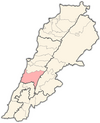Deir al-Qamar
This article includes a list of general references, but it lacks sufficient corresponding inline citations. (March 2016) |
Deir el Qamar
دير القمر | |
|---|---|
UTC+3 (EEST) | |
| Dialing code | +961 |
Deir al-Qamar (
History


Crusader period
The oldest written reference to Deir el Qamar (Deir elcamar or Deir elchamar) goes back to 1257 and 1261 in the deeds of Julian of Shouf and Andrew of Chouf selling their lands and villages in their lordship of Chouf to the
Ottoman period
During the 16th to 18th centuries, Deir al-Qamar was the capital and the residence of the
It was the first village in Lebanon to have a municipality in 1864, and it is the birthplace of many well known personalities, such as artists, writers, and politicians. It was the winter capital of the Druze Qaim-Maqamate of Lebanon (1840-1860), the summer capital being Baakleen. People from all religious backgrounds lived there and the town had a mosque, synagogue and Christian churches.
In the year 1860, Deir al-Qamar was destroyed during the
In 1864, Deir el-Qamar elected the first municipality in the Arab provinces of the Ottoman Empire.
A census undertaken in Deir al-Qamar by the Ottomans during the reign of
General aspect
The village retains a remarkable picturesque appearance with typical stone houses with red tile roofs. In 1945 it was placed under monument protection.[4][5][6]
In 1943 The Lebanese president
One of the mayors was Georges Dib Nehme who also represented the region at the Parliament.[7]

Religious sites
One of the important mosques in Deir al-Qamar is Fakhreddine Mosque and its goes back to 15th century Built in 1493 by Fakhr al-Din I and restored in the sixteenth century, it is the oldest mosque in Mount Lebanon.[1]
One of the most important historical and religious site in Deir al-Qamar is Our Lady of the Hill known as
According to the Maronite Heritage web site, "the legend says that there was a Druze Emir in Baakline looking at the hill of Deir al-Qamar. He saw a light coming out of the hill. He gathered his soldiers and ordered them to go in the morning and dig in the land. He said to them: 'If you find an Islamic symbol, build a mosque. If you find a Christian symbol, build a church." The soldiers went in the morning, dug in the land and found a rock with a cross on it and under the cross there was the Moon and Venus. That was the sign that long time ago, there was a temple dedicated to the Moon and Venus and later it became a church. Earthquakes and wars might be the reason for its disappearance." The rock discovered by the soldiers can be found above the old gate of the church. A Byzantine column can be found inside the church. The inhabitants honor a miraculous icon of our Lady of the Hill placed behind the altar. It was painted in 1867 by the Italian artist Guerra. On the feast of Our Lady of the Hill- the first Sunday of August - thousands of believers go in a big procession with the miraculous icon from the entrance of Deir al-Qamar to the Church.
Another important religious site in Deir al-Qamar is the Mount of the Cross where pilgrims visit the Lamb of God Shrine (built in 2007), Father Yacoub Church (restored and consecrated as a church on June 24, 2008) and the Cross (built by Fr. Yacoub in 1932).[8]
Deir al-Qamar also had a well-established
Wax museum
The Marie Baz
-
Marie Baz Wax Museum
-
Fountain inside the Marie Baz Wax Museum
-
Room dedicated to the history of the Baz family and one of the entries
-
Statue of the Holy Family-baby Jesus, mother Mary and Saint Joseph
-
Wax figures
-
Wax figures
-
Wax figures
-
Wax figures
-
Baz family history room
-
Baz family history room
-
Baz family history room
Image gallery
-
Old place Deir El-Qamar and houses in the background
-
Entrance to the Maronite Church of Notre-Dame de la Colline
-
Maronite Church of Our Lady of the Hill
-
Tourist information
-
Tourist information
-
Interior of the Maronite Church of Our Lady of the Hill
-
Rosemary in bloom in a street of Deir El-Qamar
-
Valley view
-
Overview of the city of Deir El-Qamar
-
Green spaces in a street of Deir El-Qamar
-
Fakhreddine Mosque built by Fakhr-ad-Din in 1493 and restored in the sixteenth century by the namesake emir, it is the oldest mosque in Mount Lebanon.
-
Synagogue of Deir al-Qamar.
-
Synagogue of Deir al-Qamar.
See also
- Fakhreddine Mosque
- Fakhreddine II Palace
- Church of Saidet et Tallé
- Deir el Qamar Synagogue
- Emirate of Mount Lebanon
- Maronite-Druze dualism
References
- ^ Strehlke, 1869, pp. 90, 103
- ^ Emir Youssef Chehab palace
- ^ See eg the 1860 discussion in the British Parliament
- ^ C, F. (2017-08-11). "Deir el-Qamar : quand histoire, patrimoine et nature sauvage font le charme d'un village - F. C." L'Orient-Le Jour (in French). Retrieved 2019-03-22.
- ^ Bacha, François El (2018-11-29). "Liban/Patrimoine: la localité de Deir el Qamar". Libnanews, Le Média Citoyen du Liban (in French). Retrieved 2019-03-22.
- ^ "Deir el-Qamar". Les Plus Beaux Villages du Liban (in French). Retrieved 2019-03-22.
- ISBN 978-3-598-07734-0.
- ^ "Deir el Kamar". Maronite Heritage. 2010.
- ^ "Patrimoine et histoire..." www.rdl.com.lb. Retrieved 2019-03-21.
Bibliography
- Strehlke, E. [in German], ed. (1869). Tabulae Ordinis Theutonici ex tabularii regii Berolinensis codice potissimum. Berlin: Weidmanns.

























